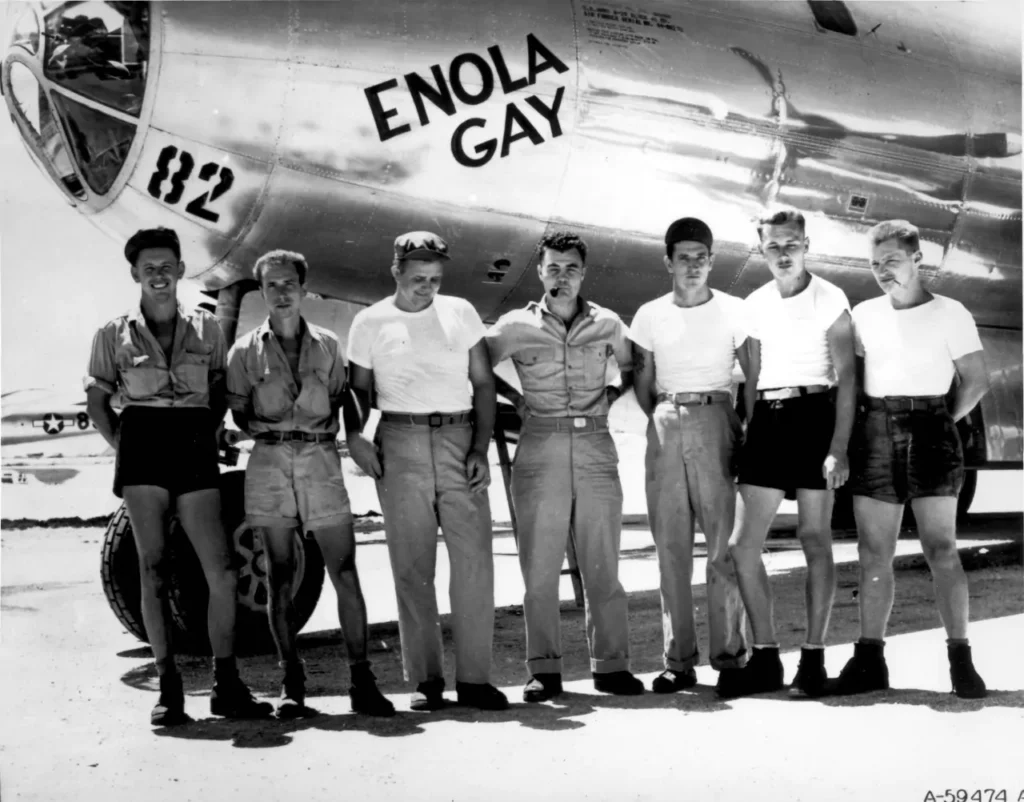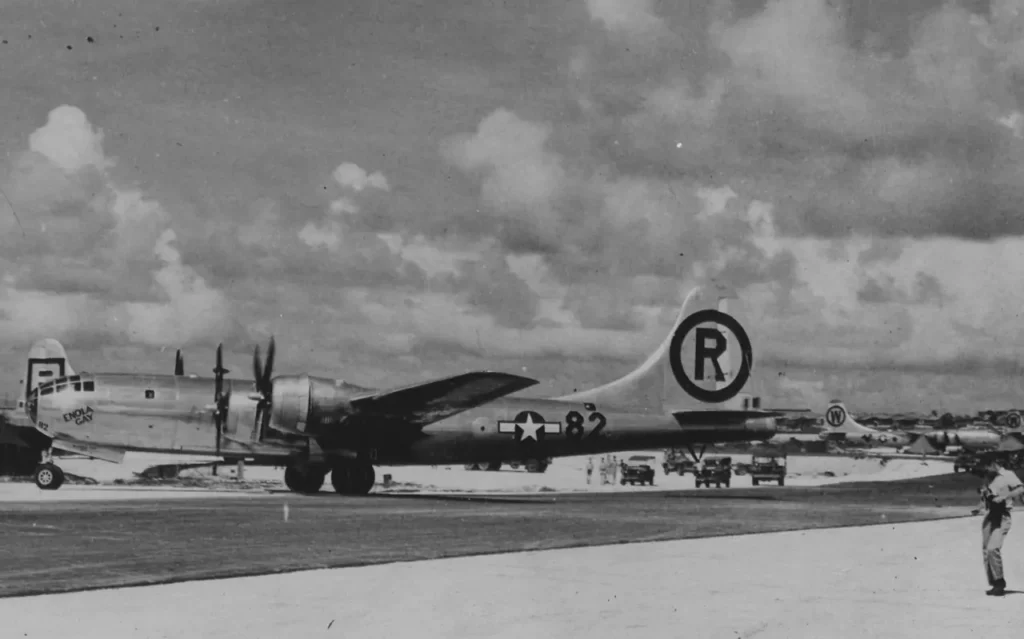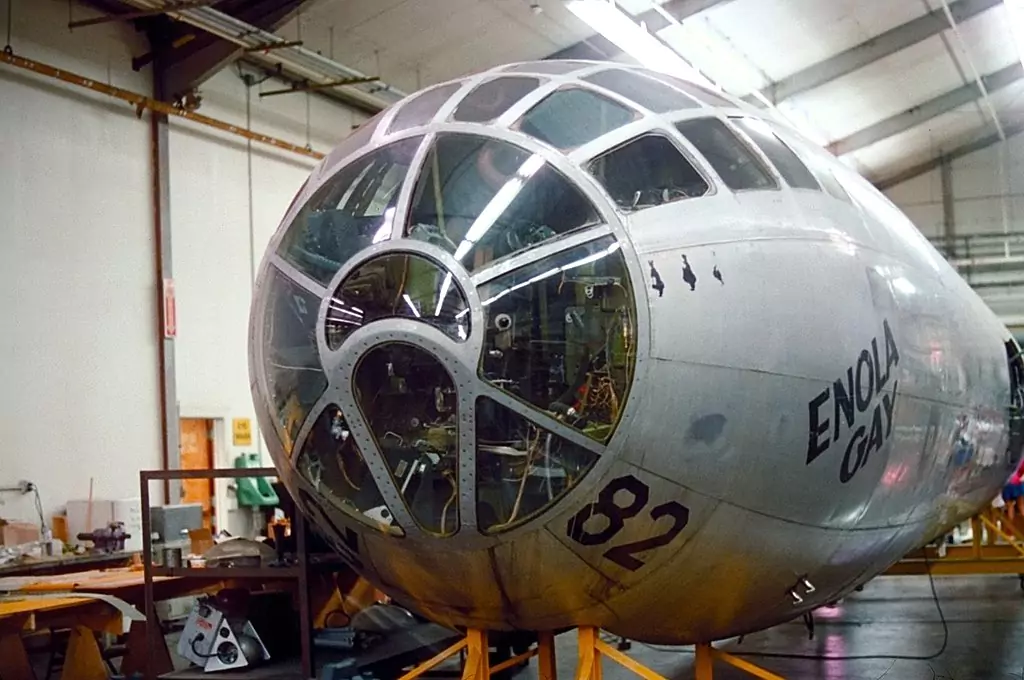The Boeing B-29 Superfortress, known as the Enola Gay, played a pivotal role in World War II as it dropped the first atomic bomb over Hiroshima, Japan on August 6, 1945.
This significant act in history marked a turning point in warfare and continues to be a point of discussion even today. However, Enola Gay’s journey extends beyond Hiroshima.
In this chronology, we trace the remarkable timeline of the aircraft, from its creation to its eventual home in the National Air and Space Museum. We explore the significant milestones it crossed, weaving a comprehensive narrative of its unique and impactful history.
If you’re fascinated by the history and power of the B-29 Superfortress, don’t forget to check out our in-depth article on the B-29 Superfortress Facts.
As you explore this chronology, be sure to delve into our essential story about Enola Gay.
Let’s get started!
1944
- March 11
393rd Bombardment Squadron (Very Heavy) activated. - September 10
The 393rd Bombardment Squadron arrived at Wendover Army Air Field and was assigned directly to the Second Air Force until the creation of the 509th Composite Group - December 17
509th Composite Group activated at Wendover Army Air Field in Utah with Colonel Paul W. Tibbets Jr. appointed as Commander.
1945
- May 9
The Enola Gay (B-29 No. 44-86292) was personally selected on the assembly line by Colonel Paul W. Tibbets Jr. at the Martin aircraft factory in Omaha, Nebraska - May 18
B-29 No. 44-86292 is delivered to the Army Air Forces at the Martin factory. - June 14
No. 44-86292 is ferried to Wendover Army Air Field in Utah, piloted by Captain Robert A. Lewis and crew B-9. - June 27
Departs Wendover for Tinian North Field, piloted by Captain Lewis and crew B-9. - July 6
After a layover on Guam for a bomb bay modification, the Enola Gay arrived on Tinian. - July 7
Practice bombing mission to Marcus Island: piloted by Captain Devore and crew A-3. - July 12
Practice bombing mission to Rota Island with 1,000-pound bombs: piloted by Captain James Price and crew B-7. - July 16
Training mission: piloted by Captain Lewis and crew B-9. - July 17
Training mission: piloted by Captain Lewis and crew B-9.
Practice bombing mission to Guguan Island: piloted by Captain Lewis and crew B-9.

- July 19
Practice bombing mission to Guguan Island with 1,000-pound bombs: piloted by Captain Wilson and crew B-6. - July 20
Ten 509th B-29s attack the Japanese cities of Koriyama, Fukushima, Nagaoka, and Toyama with Pumpkin bombs (missions 1 through 4). - July 21
Practice bombing mission to Marcus Island with 500-pound bombs, piloted by Captain Lewis and crew B-9. - July 22
Practice bombing mission with 1,000-pound bombs: piloted by 1st Lieutenant Charles McKnight and crew B-8. - July 24
Ten 509th B-29s attack the Japanese cities of Kobe, Sum- Itomo, and Yokkaichi with Pumpkin bombs (missions 5 through 7). Enola Gay dropped a pumpkin bomb on the main target – a steelworks in the Kobe area. They used visual bombing, but the effects weren’t recorded. Piloted by Captain Lewis and crew B-8. - July 26
Ten 509th B-29s attack the Japanese cities of Nagaoka and Toyama with Pumpkin bombs (missions 8 and 9). Enola Gay dropped another pumpkin bomb. This time it was on a secondary target, the urban area of Nagoya. They used radar bombing, but again, the results were not recorded. Piloted by Captain Lewis and crew B-8.
- July 29
Eight 509th B-29s attack the Japanese cities of Koriyama, Ube, and Yokkaichi with Pumpkin bombs (missions 10 through 12). - July 31
The last Little Boy test before the Hiroshima mission. Test unit L6 is loaded into Enola Gay, with Tibbets as the commander and Crew B-9. In this final practice run, the bomb-carrying plane and two other Silverplate B-29s from the 509th flew to Iwo Jima, where they met up. They then went back near Tinian, dropped the test unit, and saw that it worked properly. - August 5
- B-29 No. 44-86292 formally named Enola Gay.
- Allan L. Karl, who was part of the 509th operations, was told to paint the name on the left side of the plane’s nose, under the cockpit.
- Little Boy atomic bomb is loaded.

- August 6
Atomic bombing mission against Hiroshima, piloted by Colonel Tibbets. The aircraft departs Tinian at 2:45 A.M.; the Little Boy bomb is released over Hiroshima at 8:15 A.M.; the aircraft returns to Tinian at 2:58 P.M., a flight of 12 hours, 13 minutes (mission 13). - August 8
Six 509th B-29s attack the Japanese cities of Osaka and Yokkaichi with Pumpkin bombs (missions 14 and 15). - August 9
Bockscar attacks Nagasaki with the Fat Man atomic bomb (mission 16). The Enola Gay was used to scout the weather over Kokura, the primary target for the Nagasaki atomic bombing mission. - August 14
Seven 509th B-29s attack the Japanese cities of Koroma and Nagoya (missions 17 and 18). - November 4/6
Enola Gay departs Tinian for Roswell Army Air Field, New Mexico. - November 8
Arrives at Roswell Army Air Field.
1946
- March
It was assigned to Task Force 1.5 for use in Operation Crossroads. - April 18
Departs Roswell for Operation Crossroads, piloted by Colonel Tibbets. - April 29
Arrives at Kwajalein Island to participate in Operation Crossroads. - July
509th Composite Group is redesignated 509th Bombardment Group (Very Heavy). - July 1
Enola Gay departs Kwajalein to return to the United States. Tibbets and his crew departed Kwajalein in the Enola Gay for the U.S, arriving at Fairfield- Suisun Army Air Field. - July 2
Arrives at Fairfield-Suisun Army Air Field, California (now Travis Air Force Base). - July 24
Flown to Davis-Monthan Army Air Field, Arizona, for storage. - August 30
The Enola Gay was dropped from the U.S. Army Air Forces inventory as its title was transferred to the Smithsonian Institution.
1949
- July 3
Retrieved from storage and flown to Park Ridge (Chicago), Illinois, by Colonel Tibbets and formally transferred to the Smithsonian Institution.
1952
- January 12
It was flown from Park Ridge to Pyote Air Force Base for temporary storage.
1953
- December 2
The aircraft was flown to Andrews Air Force Base outside Washington, DC, for temporary storage.

1960
- August 10
The staff of the National Air Museum begins the disassembly of the Enola Gay at Andrews Air Force Base.
1961
- July 21
The dismantled parts of the Enola Gay are transported to the National Air Museum’s storage facility in Suitland, Maryland.
1984
- Summer
509th veterans Donald C. Rehl and Frank Stewart launch a campaign to restore the Enola Gay and found the Enola Gay Restoration Association, EGRA.
- December 5
The restoration project begins at the Garber facility.
1995
- June 28
The Enola Gay exhibit, featuring the aircraft’s forward fuselage and other parts, is inaugurated at the National Air and Space Museum, Washington, D.C.
1998

- May 18
The Enola Gay exhibit concludes, and the displayed parts are returned to the Garber facility in Suitland.
2003
- December 11
Steven F. Udvar-Hazy Center at Dulles International Airport opens with the fully assembled Enola Gay on display.
Further reading
- Boeing B-29 Superfortress Facts: 11 things to know
- The Enola Gay: The B-29 that changed warfare
- Paul W. Tibbets Jr. biography
Sources
- The Enola Gay: The B-29 That Dropped the Atomic Bomb on Hiroshima by Norman Polmar
- An Exhibit Denied: Lobbying the History of Enola Gay by Martin Harwit
- The Silverplate Bombers: A History and Registry of the Enola Gay and Other B-29s Configured to Carry Atomic Bombs by Richard H. Campbell